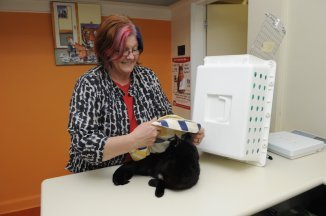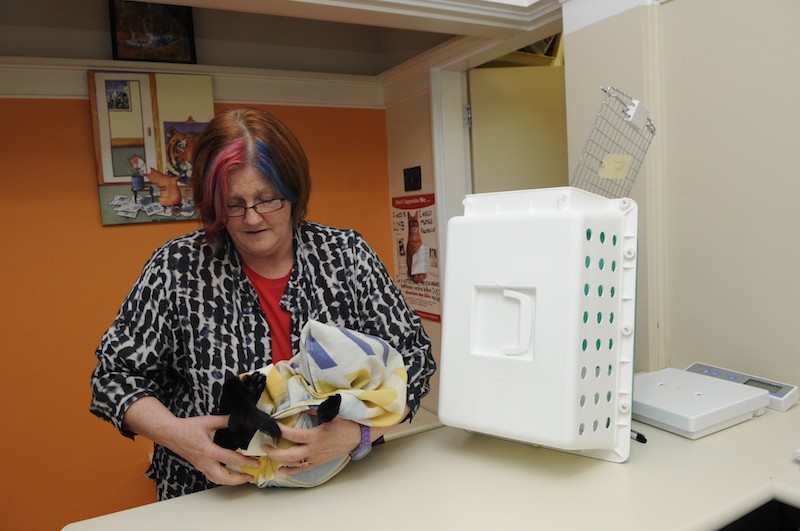
Would you rather have root canal dental treatment than transport your cat in a carrier? Are you both suffering from cat travel anxiety? Help is at hand, but it does rely on your efforts.
Getting your cat into a pet carrier takes just a little preparation
Your pet cat needs your help to get the help she needs from the vet. If she (and you) suffer from cat travel anxiety then now is the time to get you both into training and relieve the stress of getting a cat into the carrier.
The solutions on this page are divided into short term and long term strategies. Ideally you will take time to develop good cat transport habits. But the short term suggestions can also be very effective. Practice them all and see which work the best for you.
I am always very respectful of the efforts and occasional damage done to my clients when they bring their feline companion in. Like anything though, practice and planning make the whole event much easier. Putting Fluffy in a cage and transporting her to the vet or boarding house, DOES NOT HAVE TO BE SCARY but YOUR attitude matters and will play a big part in turning transport horrors into veterinary heaven.
If YOU THINK the world is going to end because you have to trap and transport your cat, then no wonder your lazy little snug ball becomes a darting scissor-handed feline frenzy when you bring in the carrier. YOU are scared of the situation, so why wouldn’t your cat be?
Even though there are a number of services that will come to your home, depending on the cat, you are probably still going to have to contain her, pending the arrival of the service person, as most cats will go AWOL as soon as there is a hint of Something Different Happening.
Seriously – it could always be a wolf in sheep’s clothing at the door.
How you can create stress free cat transport
So here are some effective strategies to avoid the major anxieties…
- The favourite, of course, is to leave the carrier in the house (not the garage) with a blanket, so kitty can snuggle in. Suddenly, the concept of “cat in a carrier” is not a new idea attached to actual transport!
- Keeping the carrier high up in a sunny spot is a favourite tip. However, as soon as you make your booking, your cat is going to KNOW something is up and The Carrier may instantly become The Enemy.
The best features for an ideal cat carrier
The CATalyst Council has done a pretty good job of describing a good carrier and how to use it but you can be more pro-active in demonstrating to the cat that the carrier is no big deal.
My provisos with this method are only that you can take the door off while the carrier is just hanging around. Some cats get their legs caught by the swinging door and that puts them off.
Also, you need to be aware of the noise that unclipping the top of the carrier makes if you are inside the carrier. It’s not always pleasant for the inhabitant!
The “blind Superman” technique
The “blind” component involves gently covering the cat’s eye so she doesn’t feel she is being “forced” into a space. I will let you work out the “Superman” part!
As you can see with all these methods you need to be confident in the process. You may find it useful practicing with a toy a few times so you can get a feeling for the best position to place the carrier and to hold the supercat!
The pillowcase method
This is absolutely my preferred method. Watch the video below or follow my photos.
You can usually bundle a cat up into a pillow case and then either open the top or tip the end of the carrier up so you can lower your cat into the carrier. Close the door and away you go. As you saw above in the “blind Superman” method you should practice to see the best position to locate the carrier.






Stay calm during the process! Otherwise your cat is definitely going to try to get away from the carrier that is clearly scaring you!
In an emergency, you can tie the pillowcase with string or a hairband, and carry your cat in that.
Tie the top of the pillowcase with string or a rubber band, you can then sit your fractious feline (on a towel in case of accidents) in a box, on your passenger’s lap or in the footwell of your car.
Surprisingly, very few felines transported in this way defecate or urinate when confined in this way.
Similarly, they do seem to do better in the fabric ‘squashy bags’ which are hugged to your side so there is less sway and instability. Obviously, there is less protection if there is a car crash.
But it is still better to have her happily contained in proper cat carrier with clean towell in the base for extra protection and the carrier in a secure position so it won’t slide when you go around corners.
On the way
Drive considerately! And if yours is one of the cats who pee, vomit or poo in the carrier – again, make sure you have extra time, plastic bags and extra bedding to exchange if it happens. This learned and fear-activated response is very hard to train out of, so starting young and making non-essential, non-threatening trips in the car is the key to preventing that problem. Many cats commute long distances without a problem – because they end up somewhere they like to be like the beach house! – but as soon as you turn off the Beach House Route to the vet, even those cats get worried. It happens. Be calm and work with the problem, not magnify it.
Once you arrive at the cat vet
Once at the vet’s, let the vet or technician decide how they like to get a cat out of the carrier. It varies between individuals, and they will be using the technique that works best for them.
I don’t dismantle the carrier – I think it makes a horrible noise unclicking the locks, and is rarely done quietly. Rebuilding the carrier is rarely any quieter than dismantling it either. And, the cats always look surprised and apprehensive when the lid is taken off – so I leave the carrier intact, and once finished all the things I need to do, I let the cat run back into the carrier. I call it ‘self-loading’ and everyone is much calmer about it.
Calming Pherenomes
So, what about pheromones? Well, certainly YOUR scent (unless you wear musk-based perfume, and that’s another story) is comforting to your cat. Wear a T-shirt for 24 hours (but not if you are going to the dentist yourself! THAT just puts your fear scent into the T-shirt) and put it in the carrier.
If your cat uses the carrier to sleep in, all the better, just leave it in there. If they pee on it during the travel, you will have to wash it and the carrier thoroughly, as it will be ‘scared pee smell’ and will put your cat off going into the carrier again. But it is a setback,, not a reason to never put your cat in a carrier again.
Feliway needs to be a regular part of the cat’s environment to be really useful in these stress situation, so don’t just spray it in the carrier before taking the cat somewhere new (or the cat will know that the smell means – new place on the horizon!). Instead. squirt a little bit onto the bedding, around the food bowl and other places your cat relaxes a couple of times a week. Acts like a massage for the emotional brain!
And, the best trick yet – use your cat’s OWN happy oils to calm them in the carrier. You know how your cat rubs their head against you whenever you come home? Those oils are their own messages, and the oils from their head area are always ‘pleased to meet you’ oils. So gather those – using a face cloth and massaging above their eyes (that little ‘bare patch’ is full of those happy scent glands. Then put that in the carrier.
Long term training
So, training for anything, started in kitten hood is easier – kittens are much more flexible in their demands than adults – but you do have to believe in what you are doing. All the cats and kittens I homed out were automatically trained to be fine in the carrier (they don’t have to love it, just not be scared of it) because they were lifted into one every day to be carried through to be weighed, then back again to have breakfast. Inbuilt reward system right there. Cats can figure that out.
So, if you have a young cat or kitten, or even if you have an older one, keep the carrier around (especially the open-topped variety) and just lift them in and out – put a treat in there if you want. You will be ‘de-sensitising’ or ‘habituating’ your cat to being lifted (gently and securely) AND being put into the carrier AND being lifted out again all in one go. Now doesn’t that sound like an important thing to do. Call it training and the cat might not like it.
Your cat will still know that you’ve made an appointment at the vet’s, though, (they really do know everything!) and will often disappear just before the allotted departure time. You just changed, by a minniscule amount, the way you looked at the cat and then the carrier. OOPS.
So apologise to the groomer or the vet (they hear the story many times) as you will be delayed, and settle on the next booking.
THIS TIME be ready to scoop your cat up a bit earlier. You’ve done a bit of lift-in-and-lift-out of the carrier so the carrier is no longer a scarey thing (it lets her out usually). So ignore the whinging (cover with a towel, and you’ve already got some calming scents in there), all will be fine – it doesn’t matter if she has to wait a few minutes longer than usual before swinging out the door. And, by the way, DON’T swing out the door.
Carry your cat politely and let the handle and your arm do the moving, not the carrier (no wonder so many cats pee in their carrier or hate it if it sways like a dingy on a choppy sea!).
